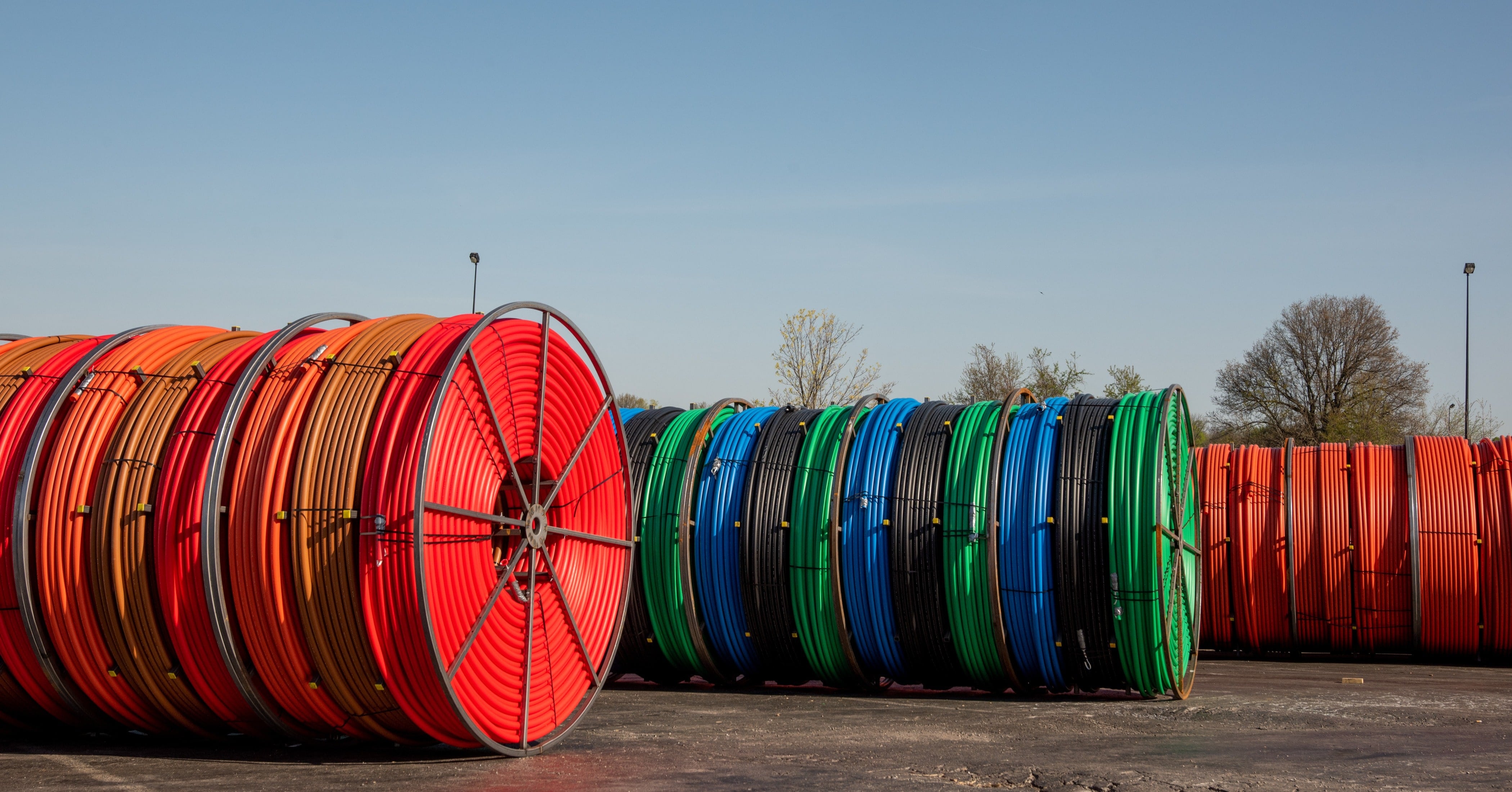HDPE pipe is the ideal material for a variety of industrial, water, sewer, and energy applications. It’s both durable and flexible, long-lasting, and easy to install. Maintenance and transportation costs are low, and the pipe can be customized for specific uses. HDPE pipe is used in both pressure (transporting fluid at high pressure) and conduit (encasing wires and cables) settings.
Pressure Applications
HDPE pipe is resistant to fatigue and handles high flow velocities. Pressure applications include water, sewer, oil and gas, mining, geothermal systems, biogas, and others.
Water
HDPE pipe has been used to transport water since the 1960s and continues to grow in popularity. It’s durable and won’t leak, rust or corrode, which is ideal for both potable and non-potable water applications. Drinking water contaminants are a concern in the U.S., as many cities have old lead or copper pipes. With HDPE pipe, there is a low risk of chemicals leaching into the water, making it a safe choice for potable water.
HDPE pipe is used for the following water applications:
- Potable Water
- Transporting drinking water for cities, municipalities, and buildings
- Reclaimed Water
- Diverting wastewater into a system for use in non-potable applications
- Applications include agriculture, toilets, and textile/paper manufacturing
- Irrigation
- Transporting water for large-scale irrigation
- Applications include agriculture/horticulture, cattle water, and golf courses
- Landfill
- Removing leachate water
- Fire protection
- Transporting water for fire hydrant supply lines and building sprinkler systems
- Electricity generation
- Geothermal energy and hydroelectric dams
Sewer
Sewage and wastewater must be transported by durable, leak-free, and corrosion-resistant pipes. HDPE meets all of these criteria. It won’t break or crack from cold weather or earthquakes, and the heat-fused joints prevent leakage. HDPE is resistant to biological growth and abrasions, so it won’t be affected by the solids in sewage and wastewater.
HDPE pipe is used for the following sewage applications:
- Transporting sewage for cities, municipalities, and large infrastructure projects
- Applications include force main sewers and gravity flow sewers
Energy and Industrial
Industrial operations like oil and gas, hydroelectric dams, and mining are often in rough environments. HDPE performs well in rugged environments and harsh climates. It is durable and will not crack or break in extreme weather conditions. Installation is easy, which is ideal for expensive operations, and the pipe can easily be pulled and moved from one location to another. Additionally, HDPE is resistant to abrasion and corrosion, which is critical when transporting chemicals, gases, and waste materials.
HDPE pipe is used for the following oil and gas, mining, geothermal, and methane capture applications:
Oil and Gas
- Transmitting oil and gas
- From the wellhead to storage tanks or sales lines
- In cross-country pipelines
- Transporting water
- Produced water
- Water treatment for oil and gas wells
- Used both before and after fracking
- Municipal and residential utilities
- Natural gas and propane
Mining
- Transporting and collecting liquids and gases
- Applications include process water, chemicals, waste, leachate, and mineral slurry
- Dewatering
- Applications include mine and pit
- Heap leaching
Geothermal Energy
- Circulating water through underground geothermal systems
- Applications include both industrial and residential geothermal systems
Hydroelectric Dams
- Transporting water
- Water is transported from the source to a holding tank to the powerhouse
Methane Capture
- Capturing and transmitting gases
-
- Methane produced on farms
- Biogas produced in landfills
Conduit Applications
HDPE pipe is used as conduit to encase electrical and telecommunication lines. It is ideal for housing power lines and cables underground, as it can withstand earthquakes and extreme temperatures and is corrosion-resistant. HDPE comes in long lengths and can be installed horizontally, which is advantageous for upgrading existing infrastructure. Conduit applications include power and telecommunications, wind and solar energy, and microduct.
Power and Telecommunications
HDPE pipes are durable and will not be affected by harsh soils or seismic events when underground. This makes HDPE the ideal material for housing critical electric and communications lines underground.
HDPE pipe is used for the following power and telecommunications applications:
- Encasing electrical power lines
- Applications include city and municipality utilities, highway lighting, site lighting, signal and control, intelligent transportation systems (ITS), and supervisory control and data acquisition (SCADA)
- Encasing cables
- Applications include fiber optic cables, telephone lines, and network cables
Clean Energy
Clean energy sources like wind and solar farms require high-voltage energy to be transported to storage centers or electrical grids. HDPE pipe is compatible with the high temperatures generated by these transfer electric lines.
HDPE pipe is used for the following wind and solar energy applications:
Wind
- Housing high-voltage transfer lines
- Lines transfer power from turbines to the storage center
Solar
- Housing high-voltage transfer lines
- Lines transfer power from solar trackers to electric grid
Microduct
Microduct HDPE pipe is a new alternative to traditional cabling. These products are typically branded by their manufacturers. For example, United Poly’s proprietary microduct product is called MicroPath. This type of pipe has multiple built-in micro ducts for fiber cabling. It is ideal in constricted areas where there is little room to expand or install new casing. Microduct is often used to replace or upgrade existing infrastructure.
HDPE pipe is used for the following microduct applications:
- High-speed telecommunications
- Housing fiber optic cables
- Utilities
HDPE’s durability and versatility make it an excellent material for a variety of pressure and conduit applications: industrial, residential, telecommunications, energy and more.

